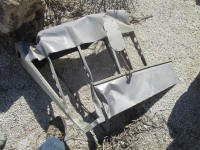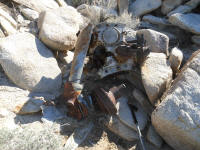|
Aircraft Wrecks in the Mountains and Deserts of the American West
(3) F4F-4
The Japanese attack
on December 7, 1941 triggered an immediate need to move military assets to the
West coast of the U.S. Into to this maelstrom flew four Grumman Wildcats flown by Ensign Carl W. Peterson in Bu No 5044, Ensign Julian Locke D’Este in Bu No 5046, Ensign Charles D. Davy in Bu No 5049, and Ensign Samuel Kime in Bu No 5053. Only one of the F4F-4’s reached civilization when Ensign Davy force landed on a roadway near the small town of Ramona some thirty plus miles northeast of San Diego and his destination of North Island Naval Air Station. Ensign Davy sustained only minor injuries, but his factory fresh Wildcat was damaged. as result Ensign Davy was written up for negligence, even though he managed to fly through the storm, and was the only survivor of this four plane flight. Search missions were launched on February 14th, and they continued until early March 1942, but no trace of the three missing Wildcats could be found. On February 14, 1942 a U.S. Navy North American SNJ-2 Bu No 2549 disappeared while participating in the search effort for the missing Wildcats. Finally on September 22, 1944 the wreckage of the SNJ-2 was spotted in the rugged San Rosa Mountains of San Diego County. The remains of the pilot, Ensign William W. Page, and his observer, Ensign Louis M. Winn were found in the wreckage by Lt. Commander James F. Patterson, Ensign Page’s former flight instructor. It took Lt. Commander Patterson three grueling days to reach the SNJ-2 crash site. Closure for one missing aircraft was achieved, but no trace of the missing Wildcats was found until late May 1952 when relic hunters stumbled upon the crash site of an F4F. In early June the navy confirmed that Bu No 5046 flown by Ens. Julian Locke D’Este had been found. In January 1955 a State Park Ranger stumbled on the D’Este site again, and reported it as the a missing aircraft. This time yellow X’s were applied to the aluminum surfaces, and the crash site was forgotten again. Finally, on March 25, 1957 two surveyors working for the State Division of Parks and Beaches found the wrecks of the Bu 5044 and Bu No 5053 flown by Ensigns Peterson and Kime. Somehow these two pilots managed to remain in formation until they crashed into rocky mountainous terrain near Cane Break Canyon. In mid-April the U.S. Navy confirmed that the remains of two missing naval aviators had been found and recovered. Yellow X’s were applied to the F4F-4 wrecks that were only 200’ apart. In the years that followed an aluminum salvager reduced all three of the Wildcat sites leaving only the armor plate, landing gear, propeller blades,Pratt & Whitney 1830-90 engines, and other sundry items of little or no salvage value. On January 2, 2015, thanks to the information supplied by a friend, a Project Remembrance Team that included Pat J. Macha, Bruce Guberman, Dennis Richardson, and David Lane located, and photo documented the crash site of Ensign Julian Locke D’Este’s Wildcat Bu No 5046. Following this successful expedition our team efforts shifted to locating the crash sites of Bu No 5044 and 5053. David lane made numerous solo sorties into the rugged, and sometimes forbidding mountains east of Highway S-1. Following a hunch David Lane found the long sought after final resting places of Ensign Kime & Peterson’s F4F-4 fighters. David Lane did it the hard way, motivated in part by the memory of his father, a WWII Wildcat pilot.
|
||||||||
|
|
||||||||


_small.jpg)
_small.jpg)

_small.jpg)
_small.jpg)
_small.jpg)